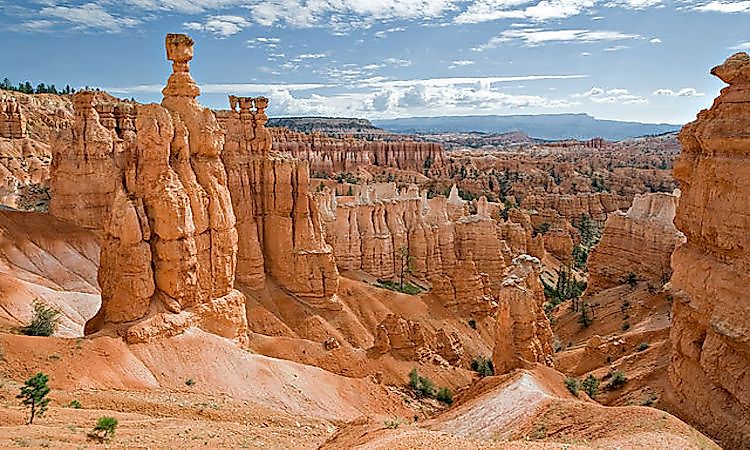Erosion Landforms: What Is A Hoodoo?

A hoodoo is a slender and tall spire of rock protruding from the base of an arid drainage basin or badland. Hoodoos portray one of the unique geological landforms formed through erosion processes. The formations are also referred as fairy chimneys, tent rocks, or earth pyramids and have been sighted in different regions of the world.
Formation Of A Hoodoo
The geological processes that lead to the hoodoo’s formation begin action on one giant plateau. In a desert setting, layers of soft rock including mudstone and tuff made of consolidated volcanic ash are overlain by a layer of durable rock such as limestone or basalt. Weather conditions from the wind, low temperatures, to rain cause the weathering of the soft layers on the side. Cracks occurring on the top layer enable water to trickle to the soft layer and cause weathering as well. Rainwater reacts with carbon dioxide to form carbonic acid which erodes the limestone on the top and causes cracks. As the weathering processes continue, a small cap of the hard rock remains to protect a cone of the soft layer below and a hoodoo is formed. The soft layer is however continuously eroded, and the formation eventually ceases to exist.
Appearance Of A Hoodoo
Hoodoos have a lumpy and bulging appearance due to the weathering processes that lead to their formation. The landform resembles a pillar or a column except with an uneven form. Hoodoos range in size from 1.5 to 45 meters, and their color depends on the minerals they contain.
Where Are Hoodoos Found?
Hoodoos primarily occur in arid regions with sporadic heavy rainfall. The landforms also form in proximity to steep slopes. The western area of the US is dotted with these landforms. The State of Utah takes the crown of the region with the largest concentration of hoodoos on the planet. The landforms are preserved in the Bryce Canyon National Park. Hoodoos in this park vary in color from white, red, to orange and can be as tall as 200 meters. The hoodoos in the park form spectacular natural amphitheaters popular with tourists. A few hundred miles away from the park is a collection of other spectacular hoodoos enclosed in the Goblin Valley State Park.
Outside of the US, hoodoos appear prominently in Turkey, specifically in Göreme, Cappadocia region. The hoodoos here resemble giant mushrooms since they are formed from volcanic rock. Yehliu Cape of northern Taiwan boasts a collection of water-eroded hoodoos, the most famous of them being the Queen’s Head. It is claimed that it resembles Queen Elizabeth I. A stretch of badland in San Juan County, New Mexico is home to strangely formed hoodoos which appear to defy gravity. Another collection of hoodoos in the country is located in Kasha-Katuwe. In Europe, the tallest hoodoos reside in South Tyrol, Italy. These formations appear spiky and are carved out from moraine clay soil. Đavolja Varoš in Serbia has 202 hoodoos which are accorded protection by the state. Other countries which also feature hoodoos are Canada, France, and New Zealand.
Significance Of Hoodoos
Hoodoos portray excellent examples of the geological process. The landforms provide scientists with identifiable and tangible illustrations to explain such processes as erosion and weathering. The hoodoos’ often strange formations have engaged the imagination of scientists as well as artists across the world. The landforms’ existence has also promoted tourism in the regions where they are located.











